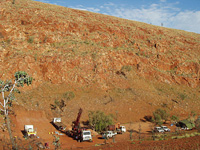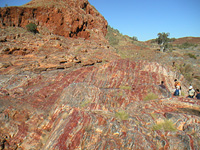|
During the summer of 2003, six holes (200 - 300m deep each) were drilled in the Pilbara district,
Western Australia to recover igneous rocks and sedimentary rocks that are 3.46 to 2.74 Ga in
age and unaffected by modern weathering. Continuous core sections (a quarter- core size) of five of
the six holes were brought back to Penn State for a variety of petrological, (bio)geochemical and
paleontological investigations.

Preliminary investigations of 3.46 Ga submarine pillow basalts and interbedded chert/jasper beds from
DDH#1 at Marble Bar using a Horiba XGT and other instruments have revealed some exciting features:
(1) hematite (Fe2O3) crystals in the jaspers and pillow lavas are not the products of modern weathering of
siderite (FeCO3) as previous investigators have suggested, but they are primary minerals that were formed
by mixing of Fe2+- and H2S-rich submarine hydrothermal fluids and an oxygenated deep (>500 m) oceanwater
3.46 Ga ago;
(2) organic carbon-rich layers (probably remnants of benthic microbial mats) developed during
cessations of submarine hydrothermal activity;
(3) uranium enrichment occurred with the organic matter of (2).
These data provide strong evidence that the oxygenated atmosphere-hydrosphere system and marine biosphere
were already developed by ~3.5 Ga ago. We will continue investigations to identify:
(a) the periodicities of submarine hydrothermal activity;
(b) the changes in cosmic fluxes and terrugenous (aerosols, volcanic ashes) fluxes;
(c) the relationships between organic-rich layers and (a) and (b);
(d) the nature of organic matter (microbial speciation);
(e) the origins of sulfur (hydrothermal, biogenic, atmospheric, MIF) in pyrite crystals; and
(f) the origins of siderite crystals.
 Drill cores #2 (3.46 Ga Towers Formation), #3 (2.76 Ga Hardy Formation), #5 (2.9 Ga Mosquito Creek Formation)
and #6 (2.7 Ga Mt. Roe Basalt Formation) contain 2 - >100 m thick black shale beds that are rich in organic
carbon and pyrite crystals. These samples will be investigated for:
(a) organic C contents;
(b) S contents;
(c) major and trace element contents;
(d) d13C of organic C and carbonates;
(e) d34S and d33S of pyrite; and
(f) the relationships among (a)-(e).
|



